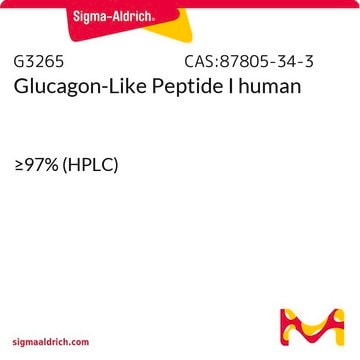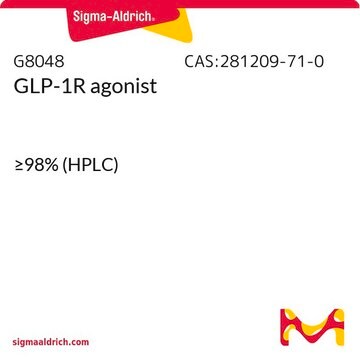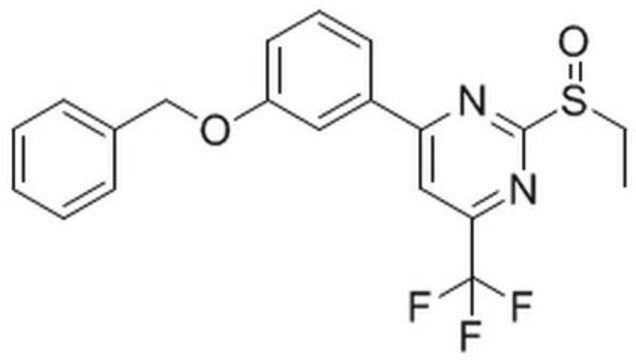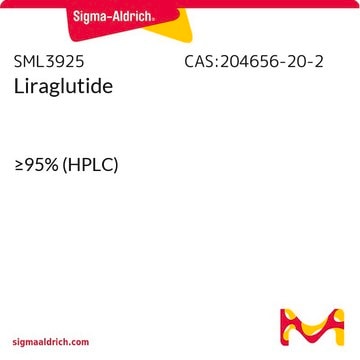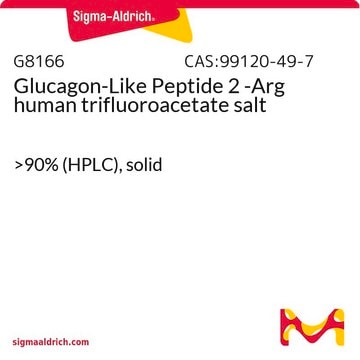G9416
Glucagon-Like Peptide 1 Fragment 7-37 human
≥96% (HPLC)
Sinónimos:
GLP-1, 7-37, Preproglucagon 78-108
About This Item
Productos recomendados
Nivel de calidad
Análisis
≥96% (HPLC)
Nº de acceso UniProt
temp. de almacenamiento
−20°C
cadena SMILES
CC[C@H](C)[C@H](NC(=O)[C@H](Cc1ccccc1)NC(=O)[C@H](CCC(O)=O)NC(=O)[C@H](CCCCN)NC(=O)[C@H](C)NC(=O)[C@H](C)NC(=O)[C@H](CCC(N)=O)NC(=O)CNC(=O)[C@H](CCC(O)=O)NC(=O)[C@H](CC(C)C)NC(=O)[C@H](Cc2ccc(O)cc2)NC(=O)[C@H](CO)NC(=O)[C@H](CO)NC(=O)[C@@H](NC(=O)[C@H](CC(O)=O)NC(=O)[C@H](CO)NC(=O)[C@@H](NC(=O)[C@H](Cc3ccccc3)NC(=O)[C@@H](NC(=O)CNC(=O)[C@H](CCC(O)=O)NC(=O)[C@H](C)NC(=O)[C@@H](N)Cc4c[nH]cn4)[C@@H](C)O)[C@@H](C)O)C(C)C)C(=O)N[C@@H](C)C(=O)N[C@@H](Cc5c[nH]c6ccccc56)C(=O)N[C@@H](CC(C)C)C(=O)N[C@@H](C(C)C)C(=O)N[C@@H](CCCCN)C(=O)NCC(=O)N[C@@H](CCCNC(N)=N)C(=O)NCC(O)=O
InChI
1S/C151H228N40O47/c1-17-77(10)121(148(236)169-81(14)127(215)177-105(60-87-63-160-92-36-25-24-35-90(87)92)138(226)179-101(56-74(4)5)139(227)188-119(75(6)7)146(234)176-94(37-26-28-52-152)130(218)161-65-111(199)170-93(39-30-54-159-151(156)157)129(217)164-68-118(210)211)190-140(228)103(57-84-31-20-18-21-32-84)180-135(223)99(47-51-116(206)207)175-134(222)95(38-27-29-53-153)172-125(213)79(12)166-124(212)78(11)168-133(221)98(44-48-110(155)198)171-112(200)66-162-132(220)97(46-50-115(204)205)174-136(224)100(55-73(2)3)178-137(225)102(59-86-40-42-89(197)43-41-86)181-143(231)107(69-192)184-145(233)109(71-194)185-147(235)120(76(8)9)189-142(230)106(62-117(208)209)182-144(232)108(70-193)186-150(238)123(83(16)196)191-141(229)104(58-85-33-22-19-23-34-85)183-149(237)122(82(15)195)187-113(201)67-163-131(219)96(45-49-114(202)203)173-126(214)80(13)167-128(216)91(154)61-88-64-158-72-165-88/h18-25,31-36,40-43,63-64,72-83,91,93-109,119-123,160,192-197H,17,26-30,37-39,44-62,65-71,152-154H2,1-16H3,(H2,155,198)(H,158,165)(H,161,218)(H,162,220)(H,163,219)(H,164,217)(H,166,212)(H,167,216)(H,168,221)(H,169,236)(H,170,199)(H,171,200)(H,172,213)(H,173,214)(H,174,224)(H,175,222)(H,176,234)(H,177,215)(H,178,225)(H,179,226)(H,180,223)(H,181,231)(H,182,232)(H,183,237)(H,184,233)(H,185,235)(H,186,238)(H,187,201)(H,188,227)(H,189,230)(H,190,228)(H,191,229)(H,202,203)(H,204,205)(H,206,207)(H,208,209)(H,210,211)(H4,156,157,159)/t77-,78-,79-,80-,81-,82+,83+,91-,93-,94-,95-,96-,97-,98-,99-,100-,101-,102-,103-,104-,105-,106-,107-,108-,109-,119-,120-,121-,122-,123-/m0/s1
Clave InChI
GCYXWQUSHADNBF-AAEALURTSA-N
Información sobre el gen
human ... GCG(2641)
Amino Acid Sequence
Descripción general
Aplicación
- as a positive control for insulin secretion of pancreatic islets
- to test its effect on insulin response in horse islets
- in combination with mesenchymal stem cells (MSCs) test its protective effects in myocardial infarction
Acciones bioquímicas o fisiológicas
Otras notas
Código de clase de almacenamiento
11 - Combustible Solids
Clase de riesgo para el agua (WGK)
WGK 3
Punto de inflamabilidad (°F)
Not applicable
Punto de inflamabilidad (°C)
Not applicable
Equipo de protección personal
Eyeshields, Gloves, type N95 (US)
Certificados de análisis (COA)
Busque Certificados de análisis (COA) introduciendo el número de lote del producto. Los números de lote se encuentran en la etiqueta del producto después de las palabras «Lot» o «Batch»
¿Ya tiene este producto?
Encuentre la documentación para los productos que ha comprado recientemente en la Biblioteca de documentos.
Los clientes también vieron
Nuestro equipo de científicos tiene experiencia en todas las áreas de investigación: Ciencias de la vida, Ciencia de los materiales, Síntesis química, Cromatografía, Analítica y muchas otras.
Póngase en contacto con el Servicio técnico